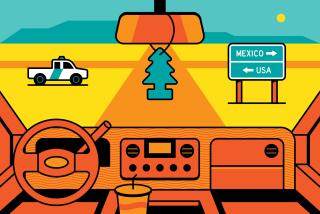Duality of UCSD’s ‘Spatial Encounters’ Works on Both the Mind and the Body
- Share via
“Spatial Encounters,” at UC San Diego’s Mandeville Gallery, is a show of two installations, one that drones through the mind and one that pulses through the body.
Both installations incorporate sound, light and symbolic and literal imagery. Both artists offer their impressions of social and historical phenomena, but neither phrases his questions in wholly convincing or moving ways.
Fred Thieme addresses the advent of the railroad, but his installation feels like a vocabulary with no grammar--the pieces are there, but they never cohere into meaningful statements.
Craig Stecyk evokes the aura of the U.S.-Mexican border in his installation. The work has a gritty, emotional appeal, but it, too, barely transcends the poignancy of its subject.
In “A Composition for Two Trains,” Thieme hangs from the ceiling two circles of model railroad track, each carrying a toy train engine. A light suspended over the center of each ring of track casts a dramatic shadow of the structure, with its zigzagging brass base, on the floor of the darkened gallery. The trains, one a steam engine and one diesel, travel in opposite directions around their separate tracks to the accompaniment of a low, droning score.
As the show’s press material explains, the sound is created by the vibration of the piano wires holding up the circles of track. Fender Bass electric pick-ups translate the sound to large, quadraphonic speakers, which fill the room with a loud, low hum.
After a brief time, the trains--and their “music”--stop, and large, photographic images are projected, alternately, on two fabric screens hanging in the far corner of the room. The black-and-white images portray trains, still and in motion, usually from an upward-looking angle that makes them appear larger than life. Recorded sounds of trains in motion, their bells ringing and engines chugging, accompanies the projections.
Thieme, a San Diego-based artist who studied at UCSD, opposes these two segments of his installation, but without clear intent. The trains in the photographs are the very image of power, strength and industrial might, the embodiment of progress, expansion and adventure. Those on the circular tracks are mere domestic toys, traveling endlessly and futilely in circles.
While the trains themselves evoke a wealth of associations, Thieme’s own perspective remains elusive. His installation can be read as a glorification of the “iron horse,” or, conversely, as a stark portrayal of the uniformity of the industrial era it ushered in. Thieme’s own voice is so muted in this spare display, however, that neither interpretation carries much weight.
Stecyk greets visitors to his installation, “Frontera” (Border), with the damp, cool smell of earth, and the slightly threatening prospect of being in a war zone. A curtain of camouflage netting frames the entrance, and aerial surveillance photographs of unidentified urban and rural areas line the walls. A khaki case for a Signal Corps telephone sits to one side, near another case housing an Immigration and Naturalization Service infrared detection unit.
A tense aura of planned violence fills the room, interrupted only by the comical presence of a few hanging pinatas, representing such American icons as George Washington, Abraham Lincoln, the $100 bill and the silver dollar.
Here, Stecyk sets the stage, casting the border as a militarized zone, a dangerous area ruled by American might. In the next, larger room, also entered through an opening in a camouflage curtain, Stecyk recreates other facets of the border: the dumping ground for trash and hazardous chemicals, the threshold of a new life for migrant workers, and the sensational subject of world news.
A ramp leads from the entrance to this room up to a small, house-like structure tiled with American and Mexican license plates and roofed with fragments of car tires. The building rises from a foundation of sandbags and assorted debris to stand as a shrine of sorts for the migrant worker.
Inside, the corners are filled with shoes, such as those cast off by migrants on their journey, Stecyk explains in an accompanying statement. A votive candle burns on the far wall and statues of religious figures stand on each side of a television set that plays a version of a news report on the degraded state of the border near the Tijuana river.
Stecyk, who lives in Los Angeles, gathered most of the materials for the show from the border area in San Diego and Tijuana. Both the authenticity of the environment and its disjunctiveness are persuasive. Faith mingles with filth in this no-man’s land, an incongruous place dense with mixed messages.
Stecyk doesn’t always avoid the rhetoric that enshrouds border culture, but he does succeed in creating an atmosphere that echoes the border itself. Faith and hope humanize this lonely, dirty place, but they are the targets of an active and ominous American military campaign.
The installation feels fragmented and rough around the edges, conceptually, but it does suggest a fundamental truth about the border. The amount of attention and resources committed to the area are not enough or not the right kind, for here the only sound is a long, howling wind--the sound of abandonment.
Both installations remain on view through June 24.
More to Read
The biggest entertainment stories
Get our big stories about Hollywood, film, television, music, arts, culture and more right in your inbox as soon as they publish.
You may occasionally receive promotional content from the Los Angeles Times.










